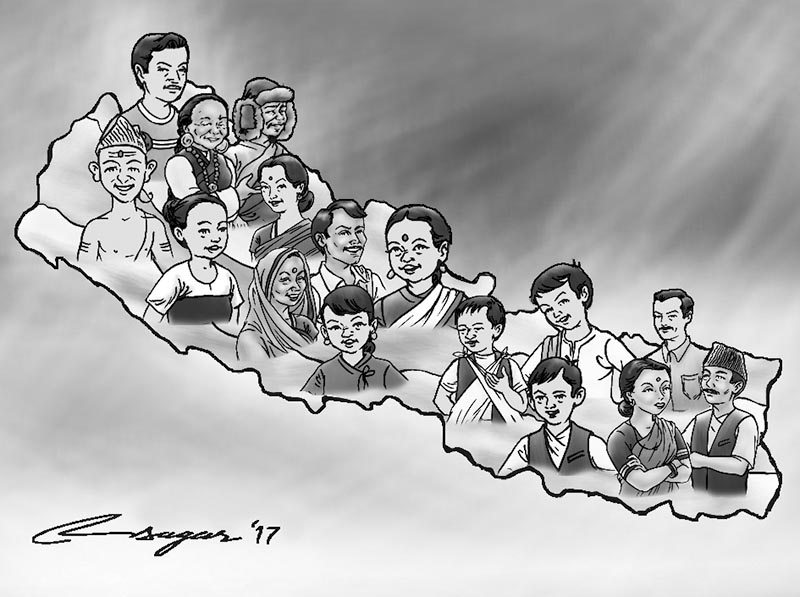Today’s Nepal: Peripheral ambiance
Marred by political instability, Nepal has experienced unusual highs and lows in terms of regime changes. In her 248 years of chequered political history, currently, Nepal is confronting the most challenging time as it strenuously struggles to give a proper direction to her democratic polity
Currently, Asia region, which accounts for 4.4 billion population, about 60% of the world, contributes to 38. 8% of the world’s GDP. As predicted by Oxford Economics, it might soar further up to 45% by 2025. Prevalence of such an ideal situation is possible provided undesired incidents do not engross the region. Nepal, located between China and India, has about 28.5 million population. It is one of the least developed nations and its 25.2% population still live below the poverty line. The country’s GDP went record low i. e. 0.8% in 2016, following a devastating earthquake, trade disruptions as well as frail monsoon. However, now Nepal’s economic growth is expected to be around 5.6% throughout 2017-18.
Nepal’s next-door neighbours China and India, which respectively with 1.39 and 1.31 billion populations, nevertheless, are now recognized among large economies in the world. Of late, as the economy swelled, their military ambitions too have soared. China’s defense spending figure, which was $131 billion in 2014, turned to $146 billion in 2015, an increase of 11% between the years. Now, for the year 2017, the military budget has increased to about $ 151.43 billion, which is about one-quarter of the U.S. defense spending i.e. $603 billion, for the year. In a similar vein, according to Institute for Defense Studies and Analysis, India has also increased its military expenditure i. e. about US$ 53.5 billion for 2017-18. Meanwhile, both Beijing and New Delhi have been engaged in modernizing and upgrading their defense systems in an unprecedented way.
Modern Nepal’s political history is not too long. After victory over Bhadgaon or Bhaktapur, modern Nepal was finally founded in 1769. Most of the time, the country had been ruled through centralized polity. From 1769 up to 1846, the Kingdom was ruled by Shah Kings. During the successive period between 1846 to 1950-51, the country’s political power was controlled by hereditary Rana Prime Ministers. Coincidentally both of them were Kshatriya by caste values and yet had come from the territory of Rajasthan prior to British Hindustan. Up until the end of Rana period, Shah Kings continued their matrimonial relations with British India. However, ever since King Mahendra’s marriage took place with the Rana clan, which had control over military might, the nuptial practice suddenly got changed in the consecutive periods with an apparent motive of new Nepali nationalism.
There was an interlude of political wrangling, between pressures for the establishment of multi-party democracy and desire for direct rule from 1951 to 1957. Eventually, that led to a democratic dispensation in the country but the egalitarian experiment ended only in 18 months. Since then, there has been a tug of war between contesting interests: movements for the restoration of democracy and continuation of centralized polity under Shah Dynasty, backed by residues of Rana oligarchy. And, they contested raucously for their respective interests and ideologies, which, ultimately, specifically with the Maoist insurgency entering democratic process, abolished the 239-year-old monarchy in 2008.
In the midst of difficult political transition, Nepal promulgated a new constitution by a Constituent Assembly in 2015. It was a cherished dream for principal pro-change forces since 1950-51. But, despite the promulgation of inclusive constitution, the nation’s tedious transition has been made more difficult as some Tarai-based parties vehemently express their resentment in various ways. Meanwhile, amid political stalemate, as issues of separation of power among legislative, executive and judiciary too have cropped up in a filthy way; the 1st phase of local level polls was held after 19 long years. Hence, as the constitution stipulates, elections of all three tiers are to be held within this year, which is likely to be a herculean task for the government if not impossible.
In the midst of massive military buildup in the vicinity, coupled with increasing tension in Korean peninsula and South Asia’s western region, Nepal is taking initiatives to graduate by 2022 as a developing nation. Marred by political instability, Nepal has experienced unusual highs and lows in terms of regime changes. In her 248 years of chequered political history, currently, Nepal is confronting the most challenging time as it strenuously struggles to give a proper direction to her democratic polity.
In the regional ambiance, although India and China dispute over territories and waters, but, as they face similar nature of security challenges such as terrorism, separatist movement, and ethnic discords; attempts are afoot to mend their fences as well. In this connection, thanks are also due to their incredible guiding principle of competing with each other while advancing functional cooperation. Concurrently, they are also working on two different but ambitious projects of “One Belt and One Road” and “Act East Policy.”
In the light of changing US’s earlier stance, as it took part in OBOR in Beijing, China’s recently floated four point proposal to India, which also includes the possibility of aligning their AE and OBOR missions, should of course be reckoned with. Together they could do a lot to the region and beyond.






